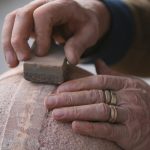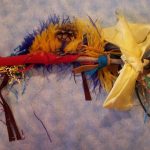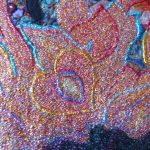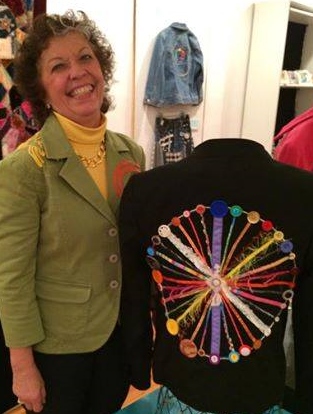An Intuitive, Creative Approach to Healing from Life’s Hurts
Or, How to E-E-E-K-K Your Way Through Adversity
to Destinations of Delight

When tough times hit and our life’s path seems to disappear in the fog; when we are faced with illness, loss, financial reversals or other adversity, it can be easy to feel like we have lost our moorings. We may struggle to keep our feet under us, or to change the metaphor, to keep our heads above water; we may be overwhelmed by it all or we may want to pretend that all is well even when we know it is not.
And if you’re a CASIGY−that is, a Creative, Alert/Aware, Super-Sensitive, Intense, likely Introverted, maybe Gifted You−you may find that adversity affects you more intensely than it seems like it should. Your sensitive Central Nervous system responds very intensely-more than for most people. Your mind goes quickly to the potential impact and ramifications of what’s happening or to all that could go wrong. Your nerve endings may be on edge, and your emotions can quickly follow suite.
Adversity can unhook anyone from our carefully constructed coping skills and set us adrift in a sea of physiological and emotional distress. For CASIGYs, our super-sensitivity can quickly trigger our intense Fight-or Flight Response, or we may be overcome with overwhelm. Either one may help us in the short term, but to stay there long term us usually counter-productive. We know that, but we aren’t always able to help ourselves get out of Overwhelm or Fight-or-Flight mode.
You might ask, what is it that actually works to help CASIGYs cope with adversity?
Is there something that will blast us back to the way life used to be, that will put everything right again? Well, yes, and no. Yes, there are coping skills that do work and will help us to get back on our feet again. Will they blast us back in time? Not really. Will they be instant? Not likely. Will they restore our lives the way they were before adversity hit? No again. Will they help us find a new equilibrium? Yes, indeed.
If it doesn’t work to blast our way back, what does work? What does work is to E-E-E-K-K our way through adversity. That will get us to new destinations of delight. Let me explain.
E-E-E-K-K stands for
- Experience it
- Explore it
- Embrace it
- Kreate something with it that represents our pain and it will heal us
- Kontemplate our creation — and it will set us free
Experience, Explore, Embrace, Create and Contemplate is a five step process containing mind-body-soul-spirit skills that will enable us to heal our emotions and our souls. We often try to numb the pain, not understanding that only when we feel it, can we heal it. Sometimes we try to numb ourselves because we feel overwhelmed by it all. Still other times, we numb ourselves because we don’t know what else to do. Most of us in modern culture have been taught from when we were knee high to a grasshopper to shut out our pain or to numb it. Unfortunately, the result of that is that our bodies become the container for all of that accumulated pain. Each time more pain comes our way, the accumulation increases and the sum total of the pain we carries increases exponentially. Instead of shutting it out or numbing it, we can learn to feel it, release it, and then to heal it. E-E-E-K-K-ing our way through painful times is a practical and effective way to release our pain and also to transform the pain into gain.
1. Experience
One day, when meeting with a client, I mentally reached for a way to help him understand and cope with his emotions. What came to me was an analogy that helped him so much that I have continued to share it with others. Many of them tell me has  helped them to understand and cope with their emotions, too. Maybe it can help you, too.
helped them to understand and cope with their emotions, too. Maybe it can help you, too.
Emotions are much like ocean waves.
Have you been in the ocean and felt the waves? Ocean waves are quite different than the waves in a lake or a river. What happens when you fight an ocean wave? Yes, you get knocked off balance faster than if you had gone with the wave.
The same thing happens with emotions: when we resist or fight them or try to pretend that we don’t have them, they grow stronger and they knock us on our keisters! It’s the old principle of “What you resist, persists.” When we flow with the wave, it passes through us and then returns back out to sea. When we flow with our emotions, they pass through us and out of us, back into the atmosphere.
Many of us are taught to resist our emotions from the time we’re babies or toddlers: “Don’t be angry,” “Don’t be sad,” and so on, we are told. Or we’re afraid to feel our emotions because of what we have experienced when others around us unleash theirs on us. We confuse feeling emotions with acting on them–sometimes because we have been on the receiving end of someone else acting out their (out-of-control) emotions.
Here’s an important truth about emotions: When we feel-and-release our emotions, we don’t have to keep them AND we don’t need to dump them on anyone else.
 This is a bit like catch-and-release fishing. We first catch the fish, then we look at it to decide what to do with it. If we decide that we don’t want to keep it, we take it off the hook and let it go back into the water. With our emotions, we allow ourselves to experience them, decide if we want to keep them; if not, we let them flow through us, just like an ocean wave flows through us–in to shore, and then back out to sea. It can be as simple as this: “Breathe in, feel [the emotion]; breathe out, let it go.” Many emotions seem to be satisfied just to be felt and acknowledged, and will leave us quickly and happily when this is done. (Click here for a PDF on using “Catch-and-Release” as a Creative Coping Tool)
This is a bit like catch-and-release fishing. We first catch the fish, then we look at it to decide what to do with it. If we decide that we don’t want to keep it, we take it off the hook and let it go back into the water. With our emotions, we allow ourselves to experience them, decide if we want to keep them; if not, we let them flow through us, just like an ocean wave flows through us–in to shore, and then back out to sea. It can be as simple as this: “Breathe in, feel [the emotion]; breathe out, let it go.” Many emotions seem to be satisfied just to be felt and acknowledged, and will leave us quickly and happily when this is done. (Click here for a PDF on using “Catch-and-Release” as a Creative Coping Tool)
2. Explore
For those complex or stubborn ones that need more than this, we Explore our emotions. What? Spend even more time and energy paying attention to what we already don’t want to have in the first place? Yes. Ironically, it’s normally the emotions that are the most difficult and that resist the catch-and-release that need this. We do it so we can eventually release them.
When we realize that an emotional wave has not released, and has not moved back out to sea, then  it can be helpful to ask ourselves some questions. We Explore our situation: What events or circumstances is this emotional wave connected to? Are these in the present or the past, or some of both? Does the size of the emotional wave match the size or significance of the event? If not, what else is this wave about? Many times, it is this process of inner exploration, which helps us connect our waves of emotion to corresponding events that allows us to release them. When it does not, it often guides us to what else we need to do in order to release them.
it can be helpful to ask ourselves some questions. We Explore our situation: What events or circumstances is this emotional wave connected to? Are these in the present or the past, or some of both? Does the size of the emotional wave match the size or significance of the event? If not, what else is this wave about? Many times, it is this process of inner exploration, which helps us connect our waves of emotion to corresponding events that allows us to release them. When it does not, it often guides us to what else we need to do in order to release them.
3. Embrace
The next thing we need to do is to Embrace what is happening, what has happened, or embrace ourselves in spite of what has happened.
We are often told to look for the good that has come or that can come as a result of difficult or painful events. This is age-old advice. It’s good advice, too; but how do we do it? Nature shows us the  way. For some of my early childhood, my family lived in a northern Wisconsin farm house. We rented the house; someone else rented the barn and the fields. I stood at the fence and watched as the cows were fed and milked. I watched as shovels full of stinky, brown muck came out of the barn, and were piled up in the barn yard. These piles were shoveled over and over and eventually shoveled into wagons my mother called Sunshine Wagons. Then the tractor was hooked up and the farmer took the no-longer-stinky loads and spread the
way. For some of my early childhood, my family lived in a northern Wisconsin farm house. We rented the house; someone else rented the barn and the fields. I stood at the fence and watched as the cows were fed and milked. I watched as shovels full of stinky, brown muck came out of the barn, and were piled up in the barn yard. These piles were shoveled over and over and eventually shoveled into wagons my mother called Sunshine Wagons. Then the tractor was hooked up and the farmer took the no-longer-stinky loads and spread the

manure on the fields.
As the manure was cured by turning it over and over, exposing every particle to the sunshine and the fresh air, over time, it gradually transformed into fertilizer. This is what we do in our own lives. We recycle the ‘manure’ life has dumped in our lives by turning it over and over, exposing it to the light and fresh air. We do this long enough and often enoug, over enough time, that it eventually transforms in fertilizer.
 Then when it becomes fertilizer, we load it into Sunshine Wagons to spread it onto the fields of our hopes and dreams, fertilizing them with Nature’s Best Nourishment: in this process, our pain turns into gain.
Then when it becomes fertilizer, we load it into Sunshine Wagons to spread it onto the fields of our hopes and dreams, fertilizing them with Nature’s Best Nourishment: in this process, our pain turns into gain.
How do we do this in our lives? One way is to tell the stories of what has happened. Many people have found that as they tell their stories, either verbally, in written form or in some other art form or craft, and as they tell the stories enough different times in enough different ways, the meaning of their stories morphs. The content of the story stays the same, but yet it changes. Each time we tell it, we express it a little differently, and we tap into a new aspect or come from a new angle. As we do this, its significance and its impact on our lives change. The telling of the story heals something deep inside, satisfies some deep, hidden need, and we are able to access something deeper, like finding treasure hidden in the deep, dark woods.
4. Create
 When we make something that represents our stories, we work with it on the metaphoric and the symbolic levels. We ‘Kreate’ something that represents our painful experiences and their impact on our lives. We make something with our hands that demonstrates what has happened, its impact on our lives, and how we feel about it.
When we make something that represents our stories, we work with it on the metaphoric and the symbolic levels. We ‘Kreate’ something that represents our painful experiences and their impact on our lives. We make something with our hands that demonstrates what has happened, its impact on our lives, and how we feel about it.
The process of making it heals us. Making something tangible can be a wonderful way for us to participate in the process of inner transformation, especially for those of us who “learn by doing”.
How do we do this? We can start by finding something that might represent the difficult or painful event or circumstance. It can  be a rock, a stick or a pine cone from outdoors. It can be a scrap of fabric, a piece of metal or wood. It can be any object you have around the house, or find. It could be a photo or momento. Whatever is intuitively right to you is what it needs to be. There is no arbitrary right or wrong to this kind of process.
be a rock, a stick or a pine cone from outdoors. It can be a scrap of fabric, a piece of metal or wood. It can be any object you have around the house, or find. It could be a photo or momento. Whatever is intuitively right to you is what it needs to be. There is no arbitrary right or wrong to this kind of process.
Once we have chosen our item, we work with it. We might take something away from it, add other things to it, decorate it, even break it or tear it up and re-form it into something else. There is no right or wrong way to approach this. We do what occurs to us. We follow our instincts and our intuition.
This is Creative Handwork.™ We work with our hands, listen with our Inner Ears; follow our Hearts; listen to and obey the directions of the Still, Small Voice. We start with one thing and end up ‘kreating’ something else with it. It is through this process of Creative Handwork ,™ that we are healed deep within. And as we make and transform this object, the pain inside us is also transformed into gain.
5. Contemplate
Finally, we contemplate what we have made. We look at it with the eye of an artist by noticing its colors,  shapes, and textures. We see the shades of light. We turn it this way and that; look at it from every angle. We listen to it with our hearts. We receive the silent messages that come to us. Messages of new meaning, new significance and often great blessing can come through these old hurts. We record these messages in words, images, in whatever form they request from us. It is as we use these tools of Creative Handwork™ and Contemplative Handwork™ that bit by bit, our pain is released and we are set free.
shapes, and textures. We see the shades of light. We turn it this way and that; look at it from every angle. We listen to it with our hearts. We receive the silent messages that come to us. Messages of new meaning, new significance and often great blessing can come through these old hurts. We record these messages in words, images, in whatever form they request from us. It is as we use these tools of Creative Handwork™ and Contemplative Handwork™ that bit by bit, our pain is released and we are set free.
To return to an earlier metaphor, composting is complete when the manure has been cured or processed  enough so that the manure no longer stinks. Cured compost becomes nature’s best fertilizer, and is now ready to be spread in a field or in a garden.
enough so that the manure no longer stinks. Cured compost becomes nature’s best fertilizer, and is now ready to be spread in a field or in a garden.
In the psychic realm, we are healed when the toxic waste from our wounds no longer stinks. This happens when its meaning is transformed. This is how good can come from bad; this is how adversity can contain the seed of equal or greater benefit.
Have you experienced this in your life? Please leave your comment below!
To connect with Sharon about how to transform your pain into gain, click here or call Sharon at 303-987-0346

